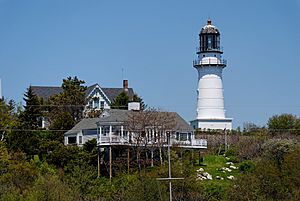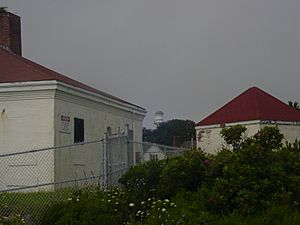Cape Elizabeth Lights facts for kids
 |
|
| Coordinates | 43°33′57.846″N 70°12′.209″W / 43.56606833°N 70.20005806°W |
|---|---|
| Year first constructed | 1828 |
| Year first lit | 1874 (current tower) |
| Automated | 1963 |
| Deactivated | West tower was deactivated in 1924 |
| Foundation | Stone |
| Construction | Cast iron |
| Tower shape | Conical tower attached to entrance tower; East tower conical without lantern |
| Markings / pattern | White with black trim, East Tower White. |
| Focal height | |
| Original lens | 2nd order Fresnel lens |
| Current lens | VRB-25 |
| Range | 15 nautical miles (28 km; 17 mi) |
| Characteristic | Fl W(4) 15s |
| Fog signal | HORN: 2 every 60s |
| Admiralty number | J0208 |
| ARLHS number | USA-113 |
| USCG number | 1-60 |
The Cape Elizabeth Light, also known as Two Lights, is a famous lighthouse in Cape Elizabeth, Maine. It stands at the entrance to Casco Bay.
This lighthouse is special because it used to have two towers. Today, only the eastern tower is still active and guides ships. The western tower is no longer used, but it's still standing and is owned by a private person.
Next to the lighthouse is Two Lights State Park. This park is a great place to see the lighthouse from afar. The Cape Elizabeth Light was designed in the Gothic Revival style. It was added to the National Register of Historic Places in 1974.
History of Two Lights
The area is called "Two Lights" because of the lighthouse's past. The first two towers were built in 1828. They were made of stone and stood about 300 yards apart. In 1869, a steam-powered warning whistle was added. This was the first one used in North America.
In 1874, the old stone towers were replaced. New towers made of cast-iron were built. Each new tower was about 67 feet (20 meters) tall. They stood 129 feet (39 meters) above sea level. Even with two bright lights, many shipwrecks happened near Cape Elizabeth.
A Heroic Rescue at the Lighthouse
One of the most exciting stories happened in January 1885. A huge snowstorm was raging. The schooner Australia crashed onto a nearby rocky ledge. Two sailors were stuck high up in the ship's rigging. They were covered in ice and couldn't move. The ship's captain drowned when a giant wave hit the deck.
The lighthouse keeper, Marcus A. Hanna, tried to save them. He tied a heavy iron weight to a strong rope. He threw the rope again and again, trying to reach the sailors. Suddenly, a huge wave smashed the schooner against the rocks. The ship tipped over.
Keeper Hanna threw his line one more time, and it landed on the schooner. One sailor managed to grab it and tie it around his waist. He jumped into the freezing sea. Keeper Hanna pulled with all his might, bringing the sailor safely over the rocky ledge.
Then, Keeper Hanna threw the line a second time. It finally reached the other sailor. This sailor also wrapped the icy rope around himself and jumped into the ocean. Keeper Hanna was almost out of strength. Just then, his assistant and two neighbors arrived. They helped pull the second man to safety. It was a truly brave rescue!
Changes Over Time
In 1924, the idea of having two lights at one spot was stopped. The western light was turned off. It was later sold in 1971 to an actor named Gary Merrill. He sold the property again in 1983.
The eastern tower is still working today as the "Cape Elizabeth Light." It's a very popular subject for artists. Famous artist Edward Hopper painted it in his works. These include Lighthouse Hill (1927) and The Lighthouse at Two Lights (1929). One of his paintings was even used on a U.S. postage stamp in 1970!



